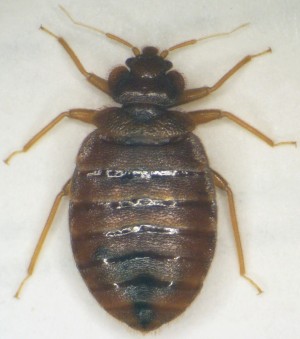 Bed Bugs - July 11, 2007 Jeff Schalau, Associate Agent, Agriculture & Natural Resources, Arizona Cooperative Extension, Yavapai County Bed bugs have been living with humans for at least the last 4,000 years of recorded history and are unlikely to disappear any time soon. Bed bug populations declined in the second half of the 20th century. This was probably due to improved building practices, education, emphasis on prevention, and wide-spread use of insecticides. Over the last few years, there has been a minor resurgence of bed bugs and you may be interested in some of the potential reasons for this resurgence as well as some simple steps to reduce the potential for bed bug infestations. The resurgence is being blamed on increased travel and immigration, reduced applications of residual pesticides (due to health and safety concerns), and the insects becoming resistant to pesticides that are used. Bed bugs had become resistant to DDT by the time it was banned in the U.S. (1972) and have since become resistant in Africa where DDT is used to battle malaria. Resistance is also building to pyrethroids: a family of insecticides commonly used in over-the-counter household insecticides and repellents. Resistance occurs when we become too reliant on one pesticide and apply it repeatedly. Some individuals in the insect population are not affected as severely and survive pesticide exposure to breed with other resistant individuals. This can lead to pesticide resistant offspring. Bed bugs can develop resistance easily in the types of environments where regular applications of insecticides are ongoing and unvaried. Large hotels in major cities are ideal breeding grounds. Bed bugs exist worldwide and are in the order Hemiptera (true bugs) and family Cimicidae which includes over 100 species. Two species live almost exclusively on human hosts. Cimex lectularius is most common to temperate areas and Cimex hemipterus is most common in the tropics. Bed bugs feed only on blood. They have been known to feed on hosts other than humans but must have human blood to moult and reproduce. Bed bug feeding usually occurs between midnight and 3 AM. It generally takes them about 10 minutes to feed. After feeding, they hide close to the host for a week or two before feeding again. They can consume 3 to 6 times their body weight in a single feeding. Bed bugs are relatively flat, so they aggregate in tight spaces such as cracks, crevices, under wall paper, or between mattresses and box springs. They can also climb walls and cling to ceilings. In recently fed adults, mating occurs and females are able to lay 3 eggs per day for about 11 days before she needs to feed again. A female may lay up to 500 eggs during her lifespan. Eggs are yellowish white capsules about 1 mm long which are laid individually and glued to available surfaces. After emerging, the young have 5 nymphal stages before becoming adults. Rate of development increases with temperature. However, they are not killed by freezes. Nymphs increase in size with each moult and must also feed on blood to continue development. Adults are wingless and about 3/8 inch long. Bed bugs cannot detect a host at distances greater than 5 feet, but can travel about as fast as an ant. Bed bugs often bite on the face, neck, and arms. If you are awake, the bite may feel like a slight tickling sensation. Their mouthparts have two tubes: one injects saliva with an anticoagulant and the other sucks up the blood directly from the capillaries. Some people are allergic to the bites but about 20% of people show no reaction to the bite. There is no evidence that bed bugs can transmit diseases to human hosts. Bed bugs are moved from place to place on furniture, baggage, boxes, packed clothing, used books, and bedding. Prevention is crucial so scrutinize any item you bring into your home. If bed bugs are identified in your home, then you must utilize integrated pest management strategies to eliminate them. This would likely include sanitation, caulking/sealing cracks and crevices, inspection of mattresses and box springs, spreading diatomaceous earth, and the use of pesticides. The University of Arizona Cooperative Extension has publications and information on indoor insects and pest control. If you have other gardening questions, call the Master Gardener line in the Cottonwood office at 646-9113 ext. 14 or E-mail us at cottonwoodmg@yahoo.com and be sure to include your address and phone number. Find past Backyard Gardener columns or submit column ideas at the Backyard Gardener web site: http://cals.arizona.edu/yavapai/anr/hort/byg/. |